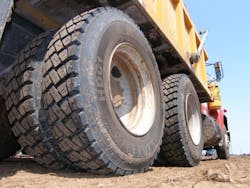Continental debuts two construction tires
Continental Tire the Americas LLC (CTA) launched two new construction tires at its Proving Grounds in Uvalde, Texas. The new medium radial truck tires represent several years of testing at the 5,000-acre facility.
The Heavy Steer Construction 1 (HSC1) and the Heavy Drive Construction 1 (HDC1) tires were designed for optimal mileage and reduced stone retention. Both tires are produced at CTA’s commercial truck tire plant in Mt. Vernon, Ill.
At a special event for fleet customers and truck tire dealers, CTA personnel outlined the company’s commitment to grow and evolve with the fast-changing truck tire market.
“Who would have thought five years ago that the main driver for transportation goods would be the fuel efficiency of tires,” says Libor Heger of CTA’s brand management segment. “It’s not mileage anymore. Fleets more and more are putting the emphasis on fuel efficiency.”
To improve fuel efficiency, CTA engineers focused on enhancing the tread design of both tires. The HSC1’s new tread design has a three-groove pattern that provides strong performance on loose surfaces. The tire’s tread depth has been increased from that of its predecessor, the HSC, from 23/32” to 24/32”. Tread width has also been increased, from 220mm to 229mm.
The HDC1’s new tread pattern has an altered tread block flank angle that reduces trapped stone by 50% from the HDC it replaces. The tread depth has also been increased, from 30/32” to 32/32”.
Both tires are available in sizes 11R22.5 and 11R24.5for load range H. TheHCS1 will be available in 12R sizes later this summer.
The tires were designed with steeper sidewalls to provide greater load-carrying capacity and improved retreadability. The new sidewalls also offer more stability and greater resistance to deformation caused by radial forces. The result is a reduction in premature material fatigue.
The new tires are made with a compound that consists of long polymer chains to prevent deep tears compared to short polymer chains. The toughness of the new on-/off-road compound means increased resistance to cuts, chips and chunks. It also reduces the number, and more importantly, the depth of any cuts and tears. In addition, it improves protection of the casing by keeping damage superficial.
“The addition of the HSC1 and HDC1 has completed our portfolio of truck tires that are ideal for coal or waste hauling, logging, construction and other on/off highway service,” says Clif Armstrong, director of commercial truck tire marketing for CTA. “Last year we introduced our new trailer tires for this segment, the HTC1 and HTL1. So with the steer and drive products launched this week at Uvalde, Continental now offers a new generation truck tire for every wheel position in construction and severe duty trucking.”
In accordance with CTA's new ContiLifeCycle approach launched in March, the tires were designed for optimum retreadability. (See ContiLifeCycle plans to expand across the land). A retread of the HTC1 will be available this summer, and one for the HDC1 will soon follow. The tires were also designed to be compliant with the EPA’s SmartWay certification requirements.
“We do a lot of testing for SmartWay certification,” says Armstrong. “We started building a new testing plan in development for SmartWay certification for either tractor enhancements, or aerodynamic elements for trailers. We also do product development testing as per the modified J1321 required by SmartWay. We run with about $250,000 worth of instrumentation in the test trucks and we measure everything – if the driver has his headlights on, if he’s got his A/C going, if he’s turning the radio up too loud – we take every variable into the test that we possibly can.”
Continental engineers take no shortcuts when it comes to improving the company’s portfolio of construction tires. Recently, one of the CTA’s construction tires for the European market was experiencing stone retention problems. In order to perform accurate tests at Continental’s Uvalde Proving Grounds, engineers took extraordinary steps.
“We shipped several tons of European rock into southern Texas so we could recreate the surface that was causing the cutting and chipping,” says Curtis Decker, Continental’s manager, product development. “That seems extreme, and it did to the drug enforcement agency. They broke down and searched all our containers of rock because they could not believe anybody would ship containers of rock across the ocean. At times, that’s what is required to address certain issues.”
Another issue addressed at CTA is the future. The company has come a long way since its inception 140 years ago. At that time, Continental’s main product was horseshoes, which is why there is a horse in the company logo. Since then, CTA has evolved to keep up with changing transportation markets.
“In the future we will add one more product group here, the hybrid segment,” says Heger. “This segment will consist of specially designed products for the long haul applications. In the construction business, we have three groups of products: Regional; on-road/off-road products; and special off-road products, such as mining. We will continue to design products for different axles and for different applications.”
